Invasive Species
Often, when the term biosecurity is used in the United States, the automatic thought process is towards the 2001 Anthrax scares, biological weapons of mass destruction, or outbreaks of diseases like the H1N1 flu outbreak of 2009. However, there is another and often overlooked threat – invasive species.
In what ways can numerous, and often small, animals or plants become a threat? There are innumerable possibilities for economic or environmental impacts stemming from an animal that has been transported into a new habitat. Although the advent of international trade has undoubtedly brought about many benefits, a downside is the potential for environmental and economic harm brought on by increasing international transport of invasive species. Invasive species are a subset of animals and plants that have been introduced to a new environment and have subsequently survived, reproduced, and caused harm.
The negative effects of invasive species are varied, but usually broken into the two aforementioned groups: environmental and economic. Environmentally, an invasive species often outcompetes native species for food and space. Economically, many aquatic invasive species have caused the collapse of local fisheries by preying on local fish or outcompeting local fish for food. Additionally, these effects are highly dependent upon the environment that these species invade (i.e., aquatic systems will be effected differently from cropland or forests).
In the United States alone, researchers estimate more than 50,000 invasive species causing economic and environmental harm.
Biological Invasions in the Great lakes
In the Great Lakes alone, there are more than 180 species of fish, plants, and crustaceans that have invaded. These animals have harmed the local fishery, industry, water quality, and cost American and Canadian taxpayers around $120 billion in prevention and control efforts every year.
Well known invasive species include the Sea Lamprey—a devastating predator of fish that entered through canals open to the ocean. In addition to being a major predator of valuable fish stocks, U.S. and Canadian governments fund over $20 million of control and eradication efforts annually. These methods are usually through the use of barriers to prevent spread as well as chemical lampricides.
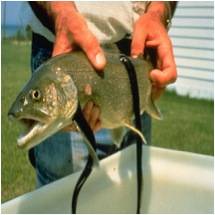
Invasive Sea Lamprey preying on a fish. Photo: Wikimedia Commons.
In the late 1800s, two species of fish were introduced to the Great Lakes. The Alewife and Chinook salmon fundamentally altered the fishery by outcompeting native fish for food. Residents of Illinois will certainly recognize the invasion of two species of Asian Carp—the Bighead and Sliver—that escaped into rivers in 1993. These fish are known to aggressively feed on plankton, a major food source of most adult fish and almost all young fish. Their invasion has lead to their dominance as a primary fish species. Furthermore, the reduction of food sources for native fish has resulted in population decline. Economically, the Asian carp species have caused major impact. And this is especially true in Illinois. In 2002, a $2.2 million electric barrier was placed in the Chicago River to prevent the fish from spreading into the Great Lakes. Four years later, a permanent barrier was put in, at a cost of $9.1 million.
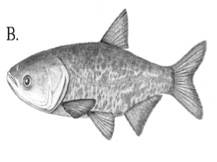
Invasive Bighead Carp. Photo: Wikimedia Commons.
Moving down the food chain, six species of crustaceans have fundamentally altered the ecosystem of the Great Lakes as well. Two species of predatory water fleas—Cercopagis pengoi and Bythotrephes longimanus—have increased predation on the plankton species of the Great Lakes. This caused an initial sharp decline in the zooplankton populations, as native species were unprepared for predation by non-fish species. As a result, effects on vital members lower down the food chain have caused a rippling effect all the way to the top predators.
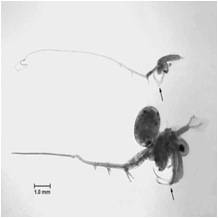
Invasive waterfleas, Cercopagis (top) and Bythotrephes (bottom). Photo: Wikimedia Commons.
Another popular example of biological invasion was that of two Dreissena species of mollusks: the Quagga- and Zebra mussels. The Zebra mussel is one of the most expensive of all aquatic invasive species to control, both economically and environmentally. These mussels reproduce quickly and numerously and attach to all hard surfaces underwater. This causes extensive “biofouling,” or accumulation of many animals on a surface, and thereby restricts water flow through municipal and industrial pipes. They also attach to boats, docks, locks, and breakwaters, impeding function and structural integrity. Environmentally, these species are aggressive filter feeders and often remove vast percentages of plankton. The Zebra mussels rapidly reduce food sources for the rest of the ecosystem. Additionally, these invasive mussels will often attach to native species. As a result, these invasives are now the dominant mussel in many areas of the Great Lakes.
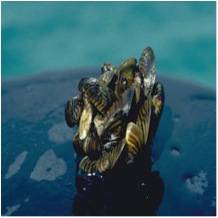
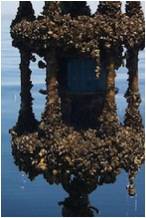
Left: Invasive Zebra Mussels growing; Right: biofouling; Photos: Wikimedia Commons.
Finally, there are more than 59 species of invasive aquatic plants including the Eurasian Watermilfoil and the Purple Loosestrife. These plants grow and reproduce faster than native species, leading to the invasive plant taking over large portions of the shoreline and often replacing dozens of native species with only a single invasive.
“A pound of prevention, plus a pound of cure”
Despite the great effort put toward containment or eradication of these invaders, they continue to grow, reproduce, and spread. When dealing with aquatic invasive species, researchers from the University of Wisconsin recommend both a pound of prevention and a pound of cure. What can you do to prevent the spread of aquatic invasive species? There are four simple steps that everyone should follow:
- When fishing, never dump your bait buckets: especially when you have live animals that are often not native to the area that you are fishing. A great alternative is to simply, always use native bait.
- Inspect everything that has become wet for any sign of aquatic hitchhikers and remove all animals and plants that you have found.
- Use hot, pressured water to clean your boats, gear, and dog.
- Allow your gear to completely dry.
For more information, see the U.S. EPA website.
Research of biological invasions involves understanding the ecology and evolution of these species. One of the many reasons for the continued research on invasive species is to better understand what makes these species harmful to aquatic environments:
- Where does it nest?
- What does it eat?
- How long does it live?
These questions are fundamental to understanding the invasive species, and to potentially reducing the effects of its invasion.
The Life-History of an Invasive Waterflea, clues for understanding Invasive Species
A major goal of research in invasion ecology is to understand how an animal’s life history—the species’ strategies for reproducing, growing, moving, and spreading to new environments—influences its ability to become an effective invasive species. Through understanding these simple characteristics, management plans may specifically target threatening invaders.
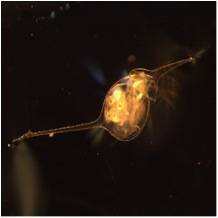
The Invasive Waterflea, Daphnia Lumhlotzi. Photo by J.W. Crawford.
In the late 1980s, the Nile Perch, an invasive fish, was stocked in Northern Texas to draw in more big-game fishing. Many researchers believe that this stocking brought the unintentional introduction. This other aquatic invasive species was the micro-crustacean Daphnia lumholtzi. This logic is sound as both the Nile Perch and Daphnia lumholtzi are native to Africa. Although Daphnia lumholtzi is relatively widespread throughout the tropics and sub-tropics of Africa, Asia, and Australia, recent genetic research from Drs. Frisch, Havel, and Weider have shown that it is highly likely that the American population came from Africa.
First scientifically recorded in the United States by researchers Sorensen and Sterner, in 1992 , this species rapidly spread across the southern United States to Georgia and Florida and up to Missouri and southern Illinois over the next 5 years.
Professor of Biology at Missouri State, John Havel, became interested in the rapid spread of this invasive species and determined during the 1990s that the primary means of spread for this invasive species was through attaching dormant eggs to the hulls of boats. When boats reach a new lake, the eggs had the opportunity to hatch and colonize a new environment. Furthermore, his research determined that this species favored large and shallow lakes that were very warm in the summer.
These high temperatures closely match the temperatures of their native Africa and research by Engel and Tollrian in 2012 have shown that Daphnia lumholtzi are the superior competitors among all zooplankton when temperatures are warm. This means that the invasive species eats, grows, and reproduces more than the native species in warm temperatures.
Dr. Tollrian of the Max-Planck-Institute in Germany conducted initial research on one of the fears of the public. Daphnia lumholtzi have a unique ability to grow a pronounced head and tail spine in order to deter predation by fish. The purpose of this spine was to make the body of the animal much longer and more difficult for the fish predators to fit into their mouth. However, by the end of the 1990s, Illinois researchers had determined that although this spine would deter the smallest fish, many would still be able to consume the invasive Daphnia lumholtzi.
Yet, for all of their predator defenses and high competitive abilities, Daphnia lumholtzi have reached a competitive coexistence in many of the lakes that it has invaded. During short portions of the summer, this species dominates the lakes in which it lives, but it is likely that cooler temperatures during the spring and fall (and certainly in Illinois winters) limit the ability of this animal to grow and reproduce. Therefore, its offspring instead remain dormant at the bottom of lakes and wait for the next spring.
I believe Daphnia lumholtzi offer the great opportunity to bring an animal into a laboratory and to study the speed at which it matures, the number of offspring it produces, the length of its life, and other factors that may determine why it has been able to invade, survive, and reproduce so far from its native Africa. In the coming years, I hope to shed more light on the process by which this invasive species—and others in the United States and elsewhere—have become entrenched so far from their native habitats.
A note on the title: Dr. Charles Elton was a prominent animal biologist who, in 1957, gave three radio broadcasts on the BBC titled, “Balance and Barrier.” Flooding his scientific report with examples of famous people from H.G. Wells to Charlie Chaplin, as well as using the vivid language of a man who had witnessed the destructive power of a world at war, Elton created one of the best broadcasts and books on Invasive Species. Not just a book for the scientific researcher, his 1958 “The Ecology of Invasions by Animals and Plants” is exceptionally well written and a wonderful source for both researchers and interested citizens. Knowing the history of biological invasions is fundamental to understanding which barriers are the most effective and the future directions of research.
Written by John Williams Crawford, Ph.D. candidate in the Department of Integrative Biology at the University of Illinois.
~~*~~
Smile Politely is proud to introduce a new running series we are calling “Science Politely” that will feature the work of graduate students at the University of Illinois throughout November and December. Working in collaboration with the students in a graduate course in Integrative Biology, Science Politely is a collaboration aimed at bridging the gap between town and university, between scientist and citizen, and between research and culture.
This work would like to credit the following sources:
Elton, Charles. 1958. The Ecology of Invasions by Animals and Plants. University of Chicago Press. Chicago and London.
Pimentel, Zuniga, and Morrison. 2005. Ecological Economics: 52.
Vander Zanden et al. 2010. Journal of Great Lakes Research: 36.
Frisch et al. 2012. Biological Invasions: 14(9).
Sorensen and Sterner. 1992. Freshwater Biology: 28.
Havel and Hebert. 1993. Limnology and Oceanography: 38(8).
Havel and Shurin. 2004. Limnology and Oceanography: 49(4). and others.
Engel and Tollrian. 2012. Journal of Plankton Research: 34(1).
Tollrian. 1994. Arch. Hydriobiol.: 130.
Kolar et al. 1997. Journal of Freshwater Ecology: 12(4).








